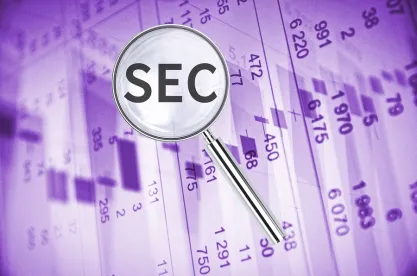LATEST DEVELOPMENTS
SEC Announces 2019 Examination Priorities
The SEC’s Office of Compliance Inspections and Examinations (OCIE) released its 2019 examination priorities on December 20, 2018. In its release, OCIE noted that it completed over 3,150 examinations in 2018, which reflected a 10% increase from the prior fiscal year.
OCIE noted its 2019 priorities have changed to address new risks that have emerged, as well as existing risks that have become heightened or been mitigated. The 2019 priorities are grouped into the following six categories:
- Matters of importance to retail investors, including seniors and those saving for retirement;
- Compliance and risk in registrants responsible for critical market infrastructure;
- Select areas and programs of FINRA and MSRB;
- Digital assets, including cryptocurrencies, coins and tokens;
- Cybersecurity; and
- Anti-money laundering (AML).
Several of these categories are described in more detail below. OCIE noted that while these priorities drive many of OCIE’s examinations, the scope of any examination is determined through a risk-based approach that includes analysis of the registrant’s operations, products offered and other factors.
Retail Investors, Including Seniors and Those Saving for Retirement
OCIE continues its focus on protecting retail investors, particularly seniors and those saving for retirement, and will focus on the following areas:
- Fees and Expenses: Disclosure of the Costs of Investing. OCIE will continue to examine fees charged to advisory accounts to ensure that fees are assessed in accordance with client agreements and firm disclosures. OCIE will look to examine firms with business models or practices that may create increased risks of inadequately disclosed fees, expenses or other charges. OCIE will continue to assess financial incentives for financial professionals that may influence their selection of particular mutual fund share classes. OCIE also remains focused on advisers participating in wrap fee programs.
- Conflicts of Interest. OCIE’s examinations will focus on policies and procedures that address, among other items, the use of affiliated service providers and products offered by such service providers and receipt of financial incentives in connection with recommending lines of credit. With respect to the use of affiliated service providers and products offered by such service providers, OCIE will focus on whether such arrangements present any conflicts of interest related to, among other items, portfolio management practices and compensation arrangements. OCIE will evaluate such arrangements and focus on the impact on clients and related disclosures of conflicts of interest.
- Senior Investors and Retirement Accounts and Products. OCIE will examine the services and products offered by investment advisers to seniors and those saving for retirement. Specifically, OCIE will focus on compliance programs, appropriateness of certain investment recommendations to seniors and supervision by firms of their employees and independent representatives.
- Portfolio Management and Trading. OCIE will examine a firm’s practices relating to: execution of investment transactions on behalf of clients; fair allocation of investment opportunities among clients; whether investments are consistent with client objectives; disclosure of critical information to clients; and compliance with other legal restrictions. OCIE will also focus on investment adviser portfolio recommendations to assess whether investment strategies are: suitable for and in the best interests of investors based on their investment objectives and risk tolerance; contrary to or straying from disclosures to investors; venturing into new and/or risky investments without adequate risk disclosure; and appropriately monitored for accompanying risks.
- Never-Before or Not Recently-Examined Advisers. OCIE will continue to examine certain advisers that have never been examined, including new registrants, and those that have not been examined for a number of years and may have changed business models or have experienced substantial increases in assets under management.
- Mutual Funds and Exchange-Traded Funds (ETFs). OCIE’s examinations will focus on: index funds tracking bespoke or custom-built indexes; ETFs with smaller assets under management and little secondary market trading volume; funds with poor performance relative to peers; funds with higher allocations to certain securitized assets; funds managed by advisers that are fairly new to managing registered funds; and advisers that provide advice to both private funds and registered funds with similar investment strategies. As discussed in further detail below, this examination priority is consistent with OCIE’s risk alert regarding its risk-based examination initiative of mutual funds and ETFs.
Digital Assets
In light of the rapid growth in the digital asset market and related risks, OCIE will focus on monitoring the offer, sale, trading and management of digital assets. OCIE will also examine products that are securities for regulatory compliance purposes. In particular, OCIE will actively work to identify market participants offering, selling, trading and managing these products or considering or actively seeking to offer such products. OCIE will also conduct examinations focused on portfolio management of digital assets, trading, safety to client funds and assets, pricing of client portfolios, compliance and internal controls for firms actively engaged in the digital asset market.
Cybersecurity
OCIE believes cybersecurity protection is critical to the operation of the financial markets and will continue to focus examinations on proper configuration of network storage devices, policies and procedures regarding retail trading information security, as well as general information security governance. OCIE will pay particular attention to the cybersecurity practices of investment advisers with multiple branch offices, including those that were recently merged with other advisers, and other areas, such as governance and risk assessment, access rights and controls, data loss prevention, vendor management, training, and incident response.
AML Programs
OCIE will focus on broker-dealer AML programs to ensure such programs include, among other things, policies and procedures reasonably designed to identify customers, monitor suspicious activity, perform customer due diligence, and, if applicable, file suspicious activity reports with FinCEN.
The SEC’s press release relating to the OCIE’s 2019 examination priorities noted that these published priorities are not exhaustive and will not be the only issues OCIE addresses in its examinations.
Sources: SEC Office of Compliance Inspections and Examinations Announces 2019 Examination Priorities (Dec. 20, 2018), available here; 2019 Examination Priorities, Office of Compliance Inspections and Examinations (Dec. 20, 2018), available here.
OCIE Issues Risk Alert Relating to Advisers’ Use of Electronic Messaging
On December 17, 2018, OCIE issued a risk alert regarding observations from its limited-scope investment adviser examination initiative relating to various forms of electronic messaging used by advisers and their personnel, risks related to such use, as well as the challenges of complying with certain provisions under the Advisers Act, including Rule 204-2 (the Books and Records Rule) and Rule 206(4)-7 (the Compliance Rule).
OCIE’s examinations focused on the following types of electronic messaging: text/SMS messaging, instant messaging, personal email and personal or private messaging. OCIE also focused on electronic communications that were conducted on an adviser’s systems or third-party applications (apps) or platforms or sent from an adviser’s computers, mobile devices issued by advisory firms or personal computers or other mobile devices used by the adviser’s personnel for the adviser’s business.
OCIE’s staff made the following observations, which may assist advisers in complying with their obligations under the Books and Records Rule and the Compliance Rule.
Policies and Procedures
- Permit only those forms of electronic communication described above for business purposes that the adviser determines can be used in compliance with the Books and Records Rule.
- Prohibit business use of apps and other technologies that may be misused because they allow employees to communicate anonymously, allow for the automatic destruction of messages or prohibit third-party viewing or back-up.
- Adopt procedures that require an employee to move messages using a form of communication prohibited for business purposes to another system that the adviser determines can be used in compliance with the Books and Records Rule.
- Implement policies and procedures to address the use of personally-owned mobile devices for business purposes, if permitted.
- Adopt and implement policies and procedures for monitoring, reviewing and retaining electronic communications if an adviser permits its personnel to use social media, personal email accounts or personal websites for business purposes.
Employee Training and Attestations
- Require personnel to complete training on an adviser’s policies and procedures regarding prohibitions and limitations placed on the use of electronic messaging and apps and any related disciplinary consequences.
- Obtain attestations relating to electronic messaging from employees at the start of employment and regularly thereafter.
- Regularly remind employees of what is permitted and prohibited under the adviser’s policies and procedures governing electronic messaging.
- Solicit feedback from employees as to what forms of electronic messaging are requested by clients and service providers.
Supervisory Review
- If permitted for business purpose use, contract with vendors to monitor social media posts, personal emails or personal websites, archive such communications in compliance with the Books and Records Rule and ensure that the adviser has the capability to identify changes to content and compare postings to a lexicon of key words and phrases.
- Regularly review social media sites to identify whether the adviser’s personnel is using social media in a way that is not permitted under the adviser’s policies and procedures.
- Run regular internet searches or set up automated alerts to notify the adviser when an employee’s or the adviser’s name appears on a website to identify any potentially unauthorized advisory business being conducted online.
- Establish a reporting program that allows employees to report, confidentially or otherwise, concerns about a colleague’s electronic messaging.
Control over Devices
- Require pre-approval from the adviser’s information technology or compliance staff before providing access to firm email servers or other business apps from personally owned devices.
- Load certain secure apps on adviser-issued or personally owned devices before allowing such devices to be used for business communications.
OCIE’s risk alert encourages advisers to review their risks, practices and policies and procedures relating to electronic communications and consider improvements to their compliance programs to ensure compliance with any applicable regulatory requirements. Some industry commentators are wary of OCIE’s recommendations, noting that certain recommendations may be impractical in the digital age and leave some unanswered questions.
Sources: OCIE National Exam Program Risk Alert-Observations from Investment Adviser Examinations Relating to Electronic Messaging (Dec. 17, 2018), available here; Jill Gregorie, SEC Electronic Comms Guidance Stuck in the Stone Age: Consultants, IGNITES (Dec. 19, 2018).
OCIE Issues Risk Alert Relating to Risk-Based Examination Initiatives Focused on Registered Investment Complexes
On November 8, 2018, and as part of OCIE’s continued focus on retail investors, OCIE indicated its examinations will focus on funds, advisers and board oversight of the topics discussed below. The risk alert indicated that OCIE would evaluate an adviser’s policies and procedures to ensure that they are designed to address risks and conflicts related to the topics below and that it would also focus on board oversight of a fund’s compliance program with respect to those matters. OCIE will also assess disclosures made to investors, as well as disclosures made to fund boards by relating to the topics below.
OCIE provided that its examinations will specifically focus on the following areas:
- Index Funds Tracking Custom-Built Indices. OCIE will evaluate the challenges and risks related to the roles of advisers and index providers in selecting and weighting custom-built or bespoke index components, performing ongoing administration of indices, managing funds and related performance advertising. Specifically, OCIE will review fund disclosures related to investment strategy, assess whether conflicts of interest are properly addressed and review the effectiveness of fund compliance programs for portfolio managers, as well as board oversight of such programs.
- Thinly-Traded or Smaller ETFs. OCIE will focus on risks related to ETFs that are thinly traded or have smaller assets under management and evaluate whether investment risks are adequately disclosed, including risk of liquidation. As part of this, OCIE stated that, in its view, Board oversight should include the review of the ongoing sustainability of an ETF.
- Mutual Funds with Poor Performance Compared to Peers. OCIE will look at factors such as asset allocation and security selection processes in order to understand a mutual fund’s aberrational underperformance compared to its peer group. OCIE will also evaluate whether a board is exercising appropriate oversight of a mutual fund’s compliance program. Specifically, OCIE will focus on the processes related to portfolio management under such programs, such as whether advisers are investing in a manner that is consistent with the investment objectives and strategies of a fund as disclosed in prospectuses and other reports to shareholders.
- Mutual Funds with Higher Allocations to Certain Securitized Assets. OCIE will evaluate if mutual funds investing in securitized assets (e.g., securitized auto loans, student loans, credit card receivables, or mortgage-backed securities) have appropriate controls in place, particularly those addressing investment risks and portfolio management. OCIE will also assess valuation and pricing policies and procedures.
- Side-by-Side Management of Mutual and Private Funds. OCIE will assess an adviser’s policies and procedures related to conflicts of interest and other risks related to side-by-side management, as well as allocation practices and controls for ensuring best execution.
- Advisers New to Management of Registered Investment Companies. OCIE will review fund governance and whether sufficient information is provided to a fund board, the effectiveness of a fund’s and adviser’s respective compliance programs and distribution and marketing efforts related to such fund.
The risk alert signals OCIE’s interest in board process and deliberations, as well as board oversight. Fund boards can use the risk alert as a way to assess whether any of the six topics listed above were presented to the board or included in board materials, if such topics were applicable.
Source: OCIE National Exam Program Risk Alert—Risk-Based Examination Initiatives Focuses on Registered Investment Companies (Nov. 8, 2018), available here; Greg Saitz, SEC Starts Funds Sweep with Questions About Their Boards, BOARD IQ (Nov. 20, 2018).
Update on Proposed Regulation Best-Interest Rule
On December 6, 2018, Chairman Clayton stated that the proposed Regulation Best Interest Rule, which would subject broker-dealers to a best interest standard when making recommendations to retail customers, would be a “key priority” for the SEC in 2019. Chairman Clayton also testified before the U.S. Senate Committee on Banking, Housing and Urban Affairs on December 11, 2018, and remarked upon the proposed Regulation Best Interest Rule. Senator Elizabeth Warren questioned the disclosure-based approach of the rule, stating that several studies, including those conducted by the SEC, have shown that disclosure-based regulations are unworkable because retail clients are still unfamiliar with the differences between investment advisers and broker-dealers and their respective responsibilities.
As discussed in our October Update, states are moving forward by passing or considering whether to pass similar fiduciary rule legislation. For example, New York passed a rule that requires advisers and broker-dealers to consider their customers’ interests when recommending annuities and life insurance products, which has a compliance date of August 1, 2019. However, two lawsuits have been filed against the New York Department of Financial Services alleging that its best interest regulation is an example of regulatory overreach. Nevada has also adopted a best interest-like regulation, although the rules for implementing this legislation have yet to be released by state regulators. Finally, other states, such as California, Connecticut, Maryland and New Jersey, have or are considering similar legislation or rules.
Source: Speech, SEC Rulemaking Over the Past Year, the Road Ahead and Challenges Posed by Brexit, LIBOR Transition and Cybersecurity Risks, Jay Clayton (Dec. 6, 2018), available here; Joe Morris, Clayton Addresses Proxy Advisers, Fiduciary Standard, Buy-Backs, Brexit with Senate, Federal Securities Law Reporter, Issue No. 2857 (Dec. 20, 2018); Beagan Wilcox, Lawsuits Challenge N.Y. Best Interest Reg, IGNITES (Nov. 30, 2018).
OCIE Issues Risk Alert Regarding Compliance Issues Related to the Cash Solicitation Rule
On October 31, 2018, OCIE issued a risk alert with information concerning the most common deficiencies the staff has cited relating to Rule 206(4)-3 of the Advisers Act (the Cash Solicitation Rule). The risk alert reflects issues identified during a review of deficiency letters from investment adviser examinations completed during the past three years and particularly focuses on observations relating to an adviser’s use of third-party solicitors (i.e., a solicitor who is not a partner, officer, director or employee of the adviser or of an entity that controls, is controlled by, or is under common control with, the adviser).
Note that investment advisers are subject to narrower requirements under the Cash Solicitation Rule when the solicitor is a partner, officer, director or employee of the adviser or of an entity that controls, is controlled by, or is under common control with, the adviser. This article summarizes certain of the requirements of the Cash Solicitation Rule identified in the risk alert.
The Cash Solicitation Rule provides that investment advisers registered (or required to be registered) under the Advisers Act cannot pay a cash fee to any person who solicits clients unless the adviser meets several conditions. Such conditions include the following:
- The fee must be paid pursuant to a written agreement, to which the adviser is a party, and requires the following:
- A description of the solicitation activities to be engaged in and the compensation to be received by the solicitor;
- The solicitor must agree to comply with the adviser’s instructions; and
- The solicitor, at the time of any solicitation activities, must provide prospective clients with a copy of (i) the adviser’s Form ADV brochure and (ii) a separate disclosure document containing certain required information.
- The adviser must receive from the client, prior to or upon entering into an advisory contract with the client, a signed and dated acknowledgement of receipt of the adviser’s Form ADV brochure and the separate disclosure document.
- The adviser must make a bona fide effort to determine whether the solicitor has complied with the written solicitation agreement, and the adviser must have a reasonable basis for believing that the solicitor has complied.
OCIE described the most frequent deficiencies it found among advisers involving the Cash Solicitation Rule. These deficiencies include:
- Solicitors not providing, or providing a deficient, solicitor disclosure document to prospective clients (e.g., providing a document that does not describe the terms of the compensation arrangement or does so in only a vague or hypothetical way);
- Advisers not receiving a signed and dated client acknowledgment of receipt of the adviser brochure and disclosure document prior to the clients’ entering into an advisory contract;
- Advisers paying fees to a solicitor without a solicitation agreement in effect, or pursuant to an agreement lacking all of the specific terms prescribed by the Cash Solicitation Rule (e.g., an agreement that does not contain an undertaking by the solicitor to perform its duties under the agreement in a manner consistent with the adviser’s instructions); and
- Advisers failing to make adequate efforts to confirm solicitor compliance with the solicitation agreement.
In light of the deficiencies noted, advisers should review and modify as necessary their compliance policies and procedures, as well as relevant documentation, to help ensure compliance with the specifics of the Cash Solicitation Rule.
Source: OCIE National Exam Program Risk Alert—Investment Adviser Compliance Issues Related to the Cash Solicitation Rule (Oct. 31, 2018),available here.
Updates to Investment Company Modernization FAQs
The SEC’s Division of Investment Management updated its frequently asked questions relating to the reporting modernization reforms for investment companies on November 14, 2018. The new guidance addresses, among other items, questions relating to the following:
- Compliance deadlines and required responses on Form N-CEN for larger fund complexes with a fiscal year ending prior to December 1, 2018;
- The calculation of performance returns on Form N-PORT, which are presented monthly and thus, unlike the return information in Form N-1A, need not reflect the deduction of sales loads and redemption fees;
- Filing requirements on Forms N-PORT and N-CEN for funds that have been liquidated, merged or otherwise terminated and have no remaining investors or investments, but the registrant has not yet deregistered (the SEC staff also reminded funds to deactivate EDGAR series and class identifiers in this situation);
- Form N-PORT filing requirements for new funds that have yet to publicly issue shares;
- How to respond to specific disclosure requirements under Regulation S-X regarding the notional amount of derivative contracts where the underlying assets are indices or baskets of investments; and
- The SEC’s online tool that will allow registrants to manually report data on Form N-CEN in lieu of submitting an XML file.
Source: Investment Company Reporting Modernization Frequently Asked Questions (Nov. 14, 2018), available here.
SEC Releases Rule Proposal for Fund of Funds Arrangements
The SEC has recently proposed a new rule that would permit registered investment companies to acquire securities of other registered investment companies in excess of the limits set forth in the 1940 Act without the need for obtaining an individual exemptive order from the SEC. The SEC stated that the proposed rule reflects decades of the Commission’s experience with “fund of funds” arrangements, noting that funds increasingly invest in other funds to achieve asset allocation, diversification or other investment objectives. The SEC staff estimates that almost 50% of all registered funds hold investments in other funds, most often U.S. equity, international equity and fixed income asset classes. The SEC believes that the proposed rule, Rule 12d1-4, would streamline and enhance the regulatory framework applicable to these fund of funds arrangements.
The 1940 Act imposes limits on the ability of a fund to make significant investments in another fund. Section 12(d)(1)(A) of the 1940 Act prohibits a registered fund from acquiring more than 3% of another fund’s outstanding voting securities; investing more than 5% of its total assets in any one fund; or investing more than 10% of its total assets in funds generally.
The new rule would permit a registered investment company to acquire shares of another fund in excess of these limits, subject to conditions that are designed to address historical abuses associated with fund of funds arrangements:
- Control and Voting. In order to address concerns that a fund could exert undue influence over another fund, the rule would prohibit an acquiring fund and its advisory group (the investment adviser and its control affiliates) from controlling, individually or in the aggregate, an acquired fund except in certain circumstances. Accordingly, funds may acquire up to 25% of the outstanding voting securities of an acquired fund. Funds would be required to use “pass-through” voting (i.e., seek voting instructions from their security holders and vote such proxies in accordance with their instructions) or “mirror” voting (i.e., vote shares held by such funds in the same proportion as the vote of all other holders of an acquired fund) in instances where the acquiring fund owns more than 3% of the acquired fund’s outstanding voting securities. Funds would no longer need to enter into participation agreements and fund boards would no longer need to make certain findings and adopt procedures to prevent overreaching and undue influence by the acquiring fund.
- Redemption Limits. To address concerns that an acquiring fund could threaten large redemptions in order to exercise undue influence, the proposed rule would prohibit an acquiring fund that acquires more than 3% of the outstanding voting securities of an acquired fund from redeeming more than 3% of an acquired fund’s total outstanding shares during any 30-day period. This requirement would shift the responsibility for monitoring redemption orders from the underlying fund to the acquiring fund and would not allow for exceptions to the 3% limit (current fund of funds rules allow underlying funds to make exceptions from redemption limits). Further, the 3% redemption limit may cause fund of fund managers to classify otherwise liquid mutual fund positions as illiquid under the new liquidity risk management rule.
- Duplicative and Excessive Fees. The proposed rule would include conditions designed to prevent duplicative or excessive fees by requiring an evaluation of the aggregate fees by the acquiring fund. The acquiring fund’s investment adviser would be required to make a determination that it is in the best interest of the acquiring fund to invest in the acquired fund. The acquiring fund’s investment adviser would be required to evaluate: (i) the complexity of the fund of funds structure; and (ii) the aggregate fees associated with the fund’s investment in an acquired fund. The investment adviser must report this determination to the acquiring fund’s board of directors initially before investing in the acquired fund and at least annually (or more frequently as the board may require).
- Complex Structures. The proposed rule would include a condition designed to prevent an acquiring fund from also being an acquired fund under the rule or the statutory exemption of Section 12(d)(1)(G). An acquiring fund relying on the proposed rule or Section 12(d)(1)(G) would be prohibited from acquiring, in excess of the existing 3%/5%/10% limits, securities of a fund that has disclosed in its most recent registration statement that it may be an acquiring fund in reliance on the new rule.
Private funds and other unregistered investment companies would not be eligible to rely on the new rule.
The SEC also proposed to amend Rule 12d1-1 to allow funds that invest in funds in the same group of investment companies to invest in unaffiliated money market funds.
The SEC has also proposed reporting requirements for funds that rely on the new rule by proposed amendments to Form N-CEN.
Because the proposed rule would provide a comprehensive exemption for fund of funds arrangements, the SEC has proposed to rescind:
- all existing individual exemptive orders for fund of funds arrangements, except with respect to certain interfund lending arrangements; and
- Rule 12d1-2 (a rule that provides exemptive relief to funds that invest in other funds that are in the same group of investment companies).
Funds relying on existing exemptive orders would have a period of one year after the effective date of the rule before rescission in order to conform their operations with the requirements of the proposed rule and rule amendments.
Sources: SEC Proposes Rule Changes for Fund of Funds Arrangements, SEC Press Release No. 2018-295 (Dec. 19, 2018), available here; Proposed Rule, Funds of Funds Arrangements, Release No. 33-10590 (Dec. 19, 2018), available here; Jill Gregory, SEC Paves Simpler Path for Fund-of-Funds Products, IGNITES (Dec. 20, 2018); Jill Gregorie, SEC Draft Fund-of-Fund Rule Favors ETFs, Throws Wrench in Liquidity Program, IGNITES (Jan. 8, 2019).
SEC Issues No-Action Letter Granting Closed-End Fund Relief Under Rule 486(b)
The SEC’s Division of Investment Management issued a no-action letter on November 5, 2018 granting relief to a registered closed-end fund complex that allows it to file immediately effective registration statements under Rule 486(b) of the Securities Act.
Rule 486(b) generally provides that each post-effective amendment to a shelf registration statement filed by interval funds (i.e., closed-end funds that make periodic repurchase offers under Rule 23c-3 of the 1940 Act) will become immediately effective upon filing with the SEC, provided that certain conditions are satisfied. The conditions require, among other items, that the post-effective amendment is filed by the interval fund for no purpose other than making non-material changes or providing updated financial statements. Rule 486(b) also allows an interval fund to make certain representations regarding the purpose of such filing.
Absent no-action relief, Section 8(c) of the Securities Act requires that each post-effective amendment to a shelf registration statement of a closed-end fund, other than an interval fund, must be reviewed and declared effective by the SEC. In this context, the closed-end fund complex sought no-action relief in order to avoid having its registration statement reviewed and commented on by the SEC. The staff granted the complex relief because it represented that the updates to its registration statement would be in compliance with the conditions set forth under Rule 486(b) even though it was not an interval fund. The no-action relief granted by the SEC is similar to relief granted to other closed-end fund complexes pursuant to prior no-action letters.
Sources: Response of the Chief Counsel’s Office, Division of Investment Management (Oct. 29, 2018), available here; Request for No-Action Relief: Eaton Vance Tax-Managed Buy-Write Opportunities Fund, Eaton Vance Tax-Managed Buy-Write Income Fund, Eaton Vance Tax-Managed Global Buy-Write Opportunities Fund and Eaton Vance Tax-Advantaged Global Dividend Opportunities Fund (Oct. 29, 2018), available here; Response of the Chief Counsel’s Office, Division of Investment Management (Oct. 4, 2018), available here; Request for No-Action Relief: DNP Select Income Fund Inc. (Oct. 4, 2018), available here; Response of the Chief Counsel’s Office, Division of Investment Management (Sept. 13, 2018), available here; Request for No-Action Relief: PIMCO Corporate & Income Opportunity Fund and PIMCO Income Opportunity Fund (Sept. 13, 2018), available here; Response of the Chief Counsel’s Office, Division of Investment Management (Feb. 14, 2018), available here; Request for No-Action Relief: Eagle Point Credit Company Inc. (Feb. 14, 2018), available here.
LITIGATION AND SEC ENFORCEMENT ACTIONS
Partial Summary Judgment Granted in Excessive Fee Suit
On October 25, 2018, the U.S. District Court for the Central District of California issued a tentative ruling granting in part and denying in part defendant Metropolitan West Asset Management, LLC’s (MetWest) motion for summary judgment in an excessive fee suit brought under Section 36(b) of the 1940 Act by a shareholder of the Metropolitan West Total Return Bond Fund. The plaintiff alleged that MetWest charged excessive advisory fees to the Fund in light of the firm providing substantially similar services for a lower fee as a sub-adviser to unaffiliated funds. After considering the Gartenberg factors, the Court granted the defendant’s motion for summary judgment as to two of the factors, nature and quality of services and fall-out benefits, noting that the plaintiff did not submit a meaningful argument that either factor leaned in his favor. The Court denied summary judgment as to the other factors.
Regarding the care and conscientiousness of the Fund board, the Court stated that, although the board’s decision to approve the advisory fee is entitled to considerable weight, there remains a triable issue of fact as to the approval process because the board did not receive or consider certain materials (the identity of the specific materials was redacted in the tentative ruling). As a result, the Court concluded that deference to the board’s decision, and therefore summary judgment as to this factor, was unwarranted. As to comparative fee structures, the Court concluded that MetWest’s reliance on peer group data to show reasonableness of the advisory fee was not sufficient to warrant summary judgment because a probative alternative “that could win the day” could be offered by comparing the fees charged by MetWest as a sub-adviser to unaffiliated funds to the advisory fee MetWest charged the Fund. The Court also refused to grant summary judgment as to economies of scale and profitability.
Source: Kennis v. Metropolitan West Asset Management, LLC, Case No. 2:15-cv-08162-GW-FFM (C.D. Cal. Oct. 25, 2018).
| Final Rule | Compliance Date(s) |
|---|---|
| Investment Company Reporting Modernization: New Form N-CEN | June 1, 2018 for all funds (first filing date is 75 days from the end of a fund’s fiscal year after June 1, 2018) |
| Liquidity Risk Management Programs (Rule 22e-4) |
Requirements of Liquidity Risk Management Program Not Subject to Extension:
Fund complexes with $1 billion or more in net assets: December 1, 2018 Fund complexes with less than $1 billion in net assets: Requirements of Liquidity Risk Management Program Subject to Extension:
Fund complexes with $1 billion or more in net assets: Fund complexes with less than $1 billion in net assets: |
| Form N-LIQUID (notice to SEC when a fund’s level of illiquid investments exceeds 15% of its net assets or when its highly liquid investments fall below minimum) |
Parts A, B and C Fund complexes with less than $1 billion in net assets: Part D Fund complexes with less than $1 billion in net assets: |
| Amendments to Form N-CEN associated with liquidity rule |
Fund complexes with $1 billion or more in net assets: Fund complexes with less than $1 billion in net assets: |
| Amendments to the certification requirements of Form N-CSR (each certifying officer must state that such officer has disclosed in the report any change in internal control over financial reporting that occurred during the most recent fiscal half-year, rather than most recent fiscal quarter) |
Fund complexes with $1 billion or more in net assets: Fund complexes with less than $1 billion in net assets: |
| Investment Company Reporting Modernization: New Form N-PORT |
Fund complexes with $1 billion or more in net assets: Note that larger fund complexes are required to maintain in their records the information that is required to be included in Form N-PORT beginning no later than July 30, 2018, based on June 30, 2018 data, in lieu of submitting the information via EDGAR. Fund complexes with less than $1 billion in net assets: |
| Rescission of Form N-Q (funds are required to continue filing Form N-Qs until they begin filing Form N-PORTs) |
Fund complexes with $1 billion or more in net assets: Fund complexes with less than $1 billion in net assets: |
| Form N-1A (narrative disclosure regarding operation of a fund’s liquidity risk management program in new subsection of the applicable shareholder report) |
Fund complexes with $1 billion or more in net assets: Fund complexes with less than $1 billion in net assets: |
| Amendments to Form N-PORT associated with liquidity rule |
Fund complexes with $1 billion or more in net assets: Note that larger fund complexes are required to maintain in their records the information that is required to be included in Form N-PORT associated with the liquidity rule beginning no later than January 31, 2019, based on December 31, 2018 data, in lieu of submitting the information via EDGAR. Fund complexes with less than $1 billion in net assets: |
| Optional Internet Availability of Fund Shareholder Reports (Rule 30e-3) |
Funds electing to distribute shareholder reports via electronic delivery at the earliest date possible (January 1, 2021) must begin including prominent disclosures on each applicable document (summary prospectus, statutory prospectus and annual and semi-annual shareholder reports) starting January 1, 2019. |







 />i
/>i

